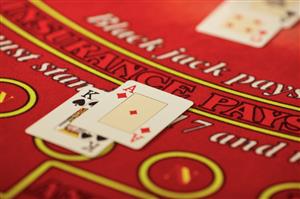The BC.Game Blackjack Hunt: Earn A Share Of €4,000 Every Week
15 Oct 2024
Read more
Blackjack Rules Explained: The Ultimate 21 Guide
This article will teach you all the basic blackjack rules to win. Learn about card values, splitting pairs, insurance, and more to increase your chances of coming out on top.

If you want to learn how to play blackjack, you’ve come to the right place. This page will talk you through all the basic principles of the game. Whether you like to play blackjack online, at a casino, or at home with friends, you’ll learn all the fundamentals here.
How To Deal in Blackjack
In blackjack, unlike many card games, you play against the dealer rather than other players. If you’re playing online or at a casino, a house representative will be the dealer. If you’re playing at home, each player will usually take turns at being the dealer.
Before the cards are dealt each player must place a bet, effectively paying to enter the game. Minimum and maximum betting limits will apply. All active players will then be dealt one card face up, including the dealer, then another card face up. On the second round, the dealer will take their card face down.
Blackjack card values
The aim of the game is for all players, plus the dealer, to get as close as possible to a score of 21 without going over. Aces are worth 1 or 11, the player can decide which, and face cards (jack, queen, king) are worth 10. Any other card is worth its pip value (the number of that particular card).
If you are dealt a score of 21, such as an ace and a 10 or an ace and a queen (11 + 10), this is known as a ‘natural’, or blackjack. If the dealer can also make a natural, ie if their face-up card is an ace or a ten-card, they will turn over their face-down card. If you and the dealer both have 21, the hand is a tie and you take back your initial bet. The dealer also collects all the bets from the players who did not make 21. If the dealer does not have 21, they will pay 1.5x of the initial bet (plus return the original stake) to all players who did made 21.
Blackjack Stand or Hit
If no players are dealt a natural, play continues to the left of the dealer. Each player must decide whether to hit (receive another card from the dealer, sometimes called ‘twist’) or stand (not receive another card, also called ‘stick’).
You can continue to hit to get as close as possible to 21. If you receive a card which brings your total over 21, you are ‘bust’. The dealer will collect your bet and move on to the next player.
Any hand where an ace is paired with a card worth 9 or less is known as a ‘soft hand’. That means you can choose whether to count the ace as 1 or 11. If you were dealt an ace and a 6, for example, you would have either 7 or 17. You must then decide whether to stick with 17 or hit and try for a higher score.
Blackjack Dealer’s Play
When all the betting players have either decided to stand or are bust, the dealer will reveal their face-down card. If their total is 17 or more, the dealer must stand, but if the total is 16 or less they must hit. If a score of 17 or more can be made with an ace, such as ace-6, the dealer must stand. They cannot choose to count the ace as 1.
If the dealer goes bust, each player who has stood will have their stake doubled and returned to them. When the dealer stands on 20 or less, any remaining player with a higher total will have their stake doubled and returned to them. The dealer will collect the bets made by the players with a lower total. If there is a tie between a player and the dealer, the player receives their stake back.
When to Split in Blackjack
If your first two cards are of the same denomination, such as two queens, you have the option of splitting. This means you will play with two hands instead of one. Your original bet will go on one card and you much match it on the other to bring that hand into play.
You start with the hand on your left and, once again, you can hit or stand. Once you either stand or are bust, play moves on to your other hand.
There are a few points of note when you split in blackjack. One is that if you split a pair of aces you will receive one card for each hand and cannot hit again. If you achieve a score of 21 in this way, ie if one of those aces is dealt a ten-card, you will receive 1x your initial bet plus your stake, not 1.5x.
When to Double Down in Blackjack
If your initial two cards total 9, 10, or 11, you can choose to double your initial bet. You will then receive one card face down, which will remain there until the bets have been settled at the end of the hand.
Blackjack Insurance
If the dealer’s face-up card is an ace, you may buy insurance against a blackjack. This can be up to half the amount of your initial bet. If any insurance bets are placed the dealer will check their face-down card. If it is indeed a ten-card, any players who bought insurance will be paid double their insurance amount.
FAQ about Blackjack Rules
Are there strategies to help me win at blackjack?
There are. Check out our blackjack strategy guide for plenty of hints and tips such as when to hit, when to stand, when to double down, and when to split.
Should you buy insurance in blackjack?
Usually no. Taking out insurance against a dealer blackjack is almost never advisable unless you’re sure that there are a high number of ten-cards still in the deck.
Are the rules of blackjack the same everywhere?
Not exactly; different casinos may have slightly different house rules. Some may only pay even money for a blackjack (rather than 1.5x), and others may not allow you to double down on a soft hand.
Ongoing Events
15 April 2025
10 Reviews
Latest games news
-
 €4,000 Weekly Pot
€4,000 Weekly Pot -
 €10,000 Prize PoolThe Rabona “Gold Saloon Race” Tournament: Win A Share Of The €10,000 Prize Pool04 May 2024 Read more
€10,000 Prize PoolThe Rabona “Gold Saloon Race” Tournament: Win A Share Of The €10,000 Prize Pool04 May 2024 Read more -
 €1,000,000 Prize PoolKingmaker Casino Blackjack League: Win A Share Of The €1,000,000 Prize Pool03 Apr 2024 Read more
€1,000,000 Prize PoolKingmaker Casino Blackjack League: Win A Share Of The €1,000,000 Prize Pool03 Apr 2024 Read more -
 $100K TournamentStake Casino $100,000 Pragmatic Extravaganza02 Apr 2024 Read more
$100K TournamentStake Casino $100,000 Pragmatic Extravaganza02 Apr 2024 Read more -
 €5,000 Prize PoolMelbet Casino September Blackjack - €5,000 Prize Pool06 Mar 2024 Read more
€5,000 Prize PoolMelbet Casino September Blackjack - €5,000 Prize Pool06 Mar 2024 Read more











Leave a comment